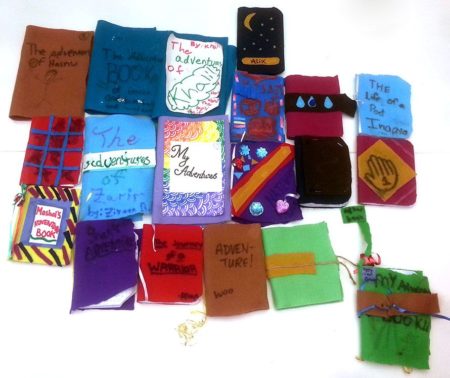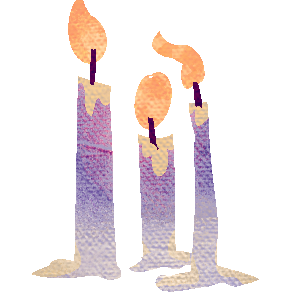
So in addition to running tabletop games twice a day for the kids’ summer camp I ran at the Aga Khan Museum, we supplemented gameplay with a few different things: firstly, we spent time every day in the museum’s collection and travelling exhibits; we read aloud stories from the Shahnameh; and we did hands on creative exercises that fed into both learning about the museum collection and enhancing the gaming experience.
Our first craft, and the one that paid off the most over the entire program, was making handmade journals. I was definitely inspired by the way Sword and Backpack uses a journal for each player as well as the GM; and as a selfpublisher, I know that making a Real Book is an incredibly empowering exercise for folks of any age. We used basic craft supplies for the covers and ¼” grid paper for the interiors, and the counselors saddle-stapled them. Each camper got to decorate the covers, “age” the interior pages and add bookmark ribbons or felt latches to theirs to make it special and ready for adventure. Each GM also made a journal, initially because we were doing demos for the kids and making journals is fun, but it turned out that they were incredibly useful for everyone in the camp, not just the campers themselves! GMs kept campaign notes, monster stats, secret plot developments and more in their journals, and I can’t imagine running a game without one now.
Once the kids all had a journal of their own, they had a place beyond their character sheets’ limited space to keep all sorts of information about their gaming. For some campers, this meant that they recorded everything that happened in the game in their journal – for others, they kept track of important clues, or of all the treasure and neat items their character acquired. Some kids immediately copied the shared map I laid out on the board on the first day into their journals, and tracked their own progress through it and referred back to it in game quite a bit. Others drew their characters, or monsters or NPCs they encountered, in the pages of their journals. The best thing was that each kid had a personal and private space to process their adventures and personalize their story.
The journals were useful beyond the gaming table as well. As I mentioned, we spent time each day in the permanent collection and in the travelling exhibits at the Aga Khan Museum, and having journals and pencils in hand helped the campers go from simply passively listening or looking as we introduced them to the material, to taking notes, organizing information and concretizing concepts into writing or drawings that they could take with them back into the classrooms or home.
The museum’s permanent collection was a little at odds with our focus on the Shahnameh, as it is focused on the history of Islam, which is the era AFTER the Shahnameh. However, the Aga Khan Museum has an incredible collection of illuminated manuscripts of the Shahnameh from across a broad swath of history, which gave us so many incredible talking points. The collection includes tablets with the images on them, which allowed the kids to zoom right in on tiny details. The paintings were amazing information resources and I was excited to share them with the campers, but in future I will spend more time teaching the kids how to parse those complex illustrations before setting them loose. Nevertheless the kids were able to use the tablets and the mounted manuscript pages to learn a lot about animals, monsters, and the kinds of clothing and architecture that would be part of their characters’ worlds in game through the illuminations. We also made use of the sculptures, decorative artworks and the textiles to help the kids glean information about what values and priorities were like in the world of the Shahnameh and afterwards.
The journals were a great anchor piece for the campers as they explored the collections – there was always a little knot of kids on benches or on the floor taking notes and drawing in them. The other amazing anchor was the game itself – campers were motivated to investigate the artifacts from their own point of view, with the intent of bringing this information into their gaming. Thus their own in-game needs and questions helped motivate them to look deeper and take good notes when they had access to the collections. I believe that using Dungeon World was extra helpful here as by the third day most campers had a clear grasp on just how much they could contribute to the world of the game, and could see the direct link between finding something interesting in the galleries and getting to encounter it in game.
Our other crafts over the week consisted of mini dioramas of the environments we were exploring, felt treasure bags and construction paper versions of treasure and equipment from in game, landmarks and monsters for the collaborative cork board map (including a few amazing 3D papercraft buildings and some narrative illustrations of battles!) and on the final day, character portraits, many of which were clearly inspired by the clothing, armour and weapons we had been studying in the illuminated manuscripts all week. As I mentioned in an earlier post, the shared map stood out to me as another incredibly powerful exercise that had the entire summer camp collaborating on populating an initially blank map in the hall and sharing stories with each other as they drew and cut out and assembled their landmarks and illustrations for it.
The final peripheral activity was the oral storytelling from the Shahnameh every day. I’ve worked with teens and adults mostly in the past and was awed by how much fun reading aloud to kids can be. Hearing their reactions to story moments and their guesses as to what comes next was definitely a highlight for me, but the best part was our discussions after each reading, where we talked about what had happened and what they thought of it all. We had some incredibly smart and investigative conversations about heroism in Rostam’s story – The kids had been paying close attention to his behaviour throughout his seven trials and when we talked about heroics they were quick to call him out on his attitude and how he treated people as well as his great deeds. We were able to dig deep into what it means to be a hero and a good person, and we were able to take those ideas of heroism into the museum galleries where other stories were shared via the illuminated manuscripts. Talking about what makes a hero was something that the kids were able to bring into their game, and I hope we introduced that classic D&D player tension of “Win All the Stuff vs Be A Real Hero” to a whole new generation.
Oh, I have one more note about the handmade journals before i wrap this up, and if this doesn’t encourage you to make them with your next group I don’t know what will: on the final day, as we wrapped up our crafts and finished our games and high fived all over the place, the kids decided that they needed to sign each others’ journals, as if they were highschool yearbooks. Each GM now has a journal full of notes from their game AND notes and signatures from all their gamers, and each camper has a journal full of notes from their gaming group and their fellow campers, and even, if they asked for one, from their GMs. It was a great way to wrap up the week and a wonderful artifact of my own that I will treasure.
So, this wraps up the Gaming at the Museum posts! Thank you so much to my Patrons whose support made this in-depth recap and analysis possible, and thanks to everyone who helped make the program itself possible, especially Alix, Casey and Jason, the best co-GMs a person could ask for. If you’re interested in reading more about museum gaming, keep an eye on Daniel Kwan’s twitter feed, and if you tackle a program like this yourself sometime please let me know all about it!
Finally, if there’s anything I haven’t covered, please feel free to drop questions in the comments here or tweet them to me on twitter, I’m definitely excited to keep talking about this!
Thanks all!

Leave a Reply